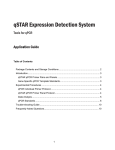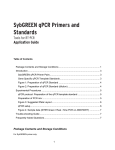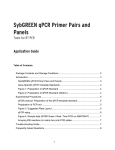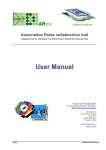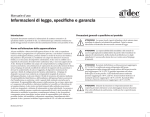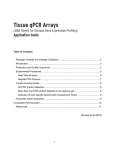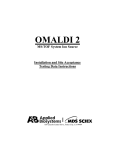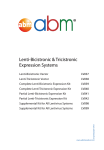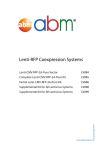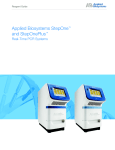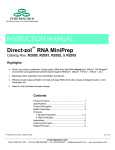Download qSTAR miRNA qPCR Detection System
Transcript
qSTAR miRNA qPCR Detection System Table of Contents Table of Contents ..............................................................................................1 Package Contents and Storage Conditions.......................................................2 For miRNA cDNA synthesis kit ......................................................................2 For qSTAR miRNA primer pairs.....................................................................2 For qSTAR miRNA qPCR primer panels .......................................................2 For qSTAR miRNA primer pairs and qSTAR miRNA standard kit .................2 Experimental Procedures ..................................................................................3 miRNA cDNA Synthesis Protocol ..................................................................3 qPCR Reaction Protocol ................................................................................4 miRNA qPCR Panel Protocol.........................................................................5 Data Analysis.................................................................................................6 qPCR Standards............................................................................................6 Frequently Asked Questions ...........................................................................10 Package Contents and Storage Conditions For miRNA cDNA synthesis kit (volumes for 10 and 50 reaction kits are listed): 1 Vial Poly (A) polymerase reaction 10X buffer (15 or 55 ul) 1 Vial 10 mM ATP (15 or 55ul) 1 Vial Poly (A) polymerase (5 unit/ μl) (15 or 55 ul) 1 Vial 5X MMLV buffer (dNTPs included) (100 or 350 ul) 1 Vial MMLV Reverse Transcriptase (15 or 55 ul) 1 Vial Oligo dT mix (15 or 55 ul) 1 Vial Control primer pair (U6) (100 or 500ul) Application Guide For qSTAR miRNA primer pairs 1 Vial qSTAR miRNA qPCR primer mix: 2 nmol lyophilized (sufficient for 200 reactions). Before use, reconstitute the primer mix in 200μl dH2O to make a final concentration of 10 μM each. Application Guide For qSTAR miRNA qPCR primer panels (2 or 10 pre-arrayed panels): 96-well or 384-well plates containing human miRNA primer pairs (623) or mouse miRNA primer pairs (485) pre-arrayed. Flash Drive containing plate layout, gene symbol, locus ID, and primer sequences Application Guide For qSTAR miRNA primer pairs and qSTAR miRNA standard kit 1 Vial qSTAR miRNA primer mix: 2 nmol lyophilized (sufficient for 200 reactions) 1 Vial miRNA specific qPCR template standard: 50 X 107 Copies (single-stranded DNA) lyophilized. Add 50 μl of d H2O to the tube and vortex briefly. The resuspended template is 10,000,000 copies/μl. 1 Vial containing 1 mL 10x PCR template standard dilution buffer. Application guide Each Kit is shipped on dry ice and should be stored at –20°C NOTE: FOR RESEARCH PURPOSES ONLY. NOT FOR DIAGNOSTIC OR THERAPEUTIC USAGE. Introduction The mammalian genome contains approximately 600 to 700 unique miRNA genes that produce a slightly higher number of mature miRNAs, each with 21-23 nucleotides in length (http://microrna.sanger.ac.uk). Evidence indicates that miRNAs are involved in many cellular processes by down-regulating gene expression, primarily at the posttranscriptional level and via imperfect complementation to mRNAs making target predictions a bit more complicated. Some miRNA have been shown to regulate a group of genes that are functionally related, such as the prevention of tumor formation and metastasis. miRNA studies have attracted a great deal of attention because of their potential as diagnostic markers and drug targets. Evidence shows certain miRNAs have aberrant expression levels in many cancer cells. miRNA expression profiling has provided invaluable insights into its biological function. Quantitive PCR is an effective tool that is commercially available for studying miRNA expression. OriGene’s miRNA detection system is one of the most comprehensive set of reliable tools for miRNA expression detection and is only one of several key products within the miRNA reagent portfolio at OriGene. OriGene’s qPCR approach. miRNAs are considered poor targets in qPCR detection due to their small molecular nature (21-23 nt) and lacking of a poly A tail at the 3 prime end, a feature that is essential in oligo dT primed cDNA synthesis. To overcome these obstacles, we adopted a polyA tailing protocol to add a poly A tail to each miRNA, followed by the use of an anchor linker oligo dT to synthesize miRNA cDNA. These cDNA molecules are effective qPCR templates in all PCR or qPCR methods. A schematic description of the process is shown in Figure 1. Fig 1. Schematic diagram of miRNA cDNA synthesis and qPCR detection. A polyA tail is added to each miRNA using E. coli polyA polymerase (I). A mixture of anchor three oligo dTs with an adaptor is used to primer the cDNA synthesis of miRNA with a polyA using MMLV reverse transcriptase. The 3 oligos differ only on the additional 5’ end residue, which is present to assist with the anchoring onto long poly-A tracts. Experimental Procedures miRNA cDNA Synthesis Protocol Prepare the following mixture in a 0.2 mL PCR tube *: Component Amount Total RNA* 1 to 2μg 10X poly A tailing Buffer 1 μl 10 mM ATP 1 μl 5 μ/μl Poly (A) polymerase 1 μl H2O Dilute to 10ul *Recommended: OriGene Vantage Total RNA (including microRNA) purification kit 1. Incubate the tube at 37ºC for 2 hours (this completes the poly-adenylation). 2. Add 1μl anchor of the oligo dT mixture to the tube and mix it and quick spin it, and then incubate the tube at 70 ºC for 5 min. 3. Put the tube on ice for 2 min and then add 4 μl 5X MMLV buffer, 5 μl H2O and 1 μl MMLV. 4. Incubate the tube at 42 ºC for 1 hour and then 95 ºC for 5 min and then place on ice. 5. Transfer the reaction mixture to an Eppendorf tube and add 200 μl H2O. The cDNA sample is ready for qPCR. * Note this protocol can easily scale up to 10 fold qPCR Reaction Protocol Each primer pair is supplied as a lyophilized powder (2 nmol total or 1 nmol of each primer). Before use, reconstitute the primer mix in 200μl dH2O to make a final concentration of 10 uM. 1. Transfer 2 μl of the miRNA cDNA sample to wells of a suitable qPCR plate and add 1 μl qPCR primer pair mixture for each target or U6 positive control, add 9.5 μl H2O to each well. 2. Include 6-fold serial dilutions of a corresponding template standard in separate wells for standardizing copy number of an unknown sample (optional) 3. Add 12.5 μl 2X SYBR Green I qPCR master mix. 4. Set up the PCR run according to the machine’s user manual. Be sure to set the annealing temperature at 55 ºC. 5. Start the PCR reaction. 6. Analyze the data according to the machine’s user manual. The following conditions can be used as a reference, but we strongly suggest that the program be optimized for your primers. Activation Pre-soak Denaturation Annealing Extension Cycles 42 50°C for 2 min** 95°C for 10 min 95°C for 15 sec 55°C for 10 sec 72°C for 30 sec *Certain SYBR Green Master mixes require a specific activation step. Refer to the manufacturer’s manual. When using a miRNA template standard to detect the copy number in an unknown sample, simply replace the synthesized cDNA with a corresponding dilution and follow the same protocol. miRNA qPCR Panel Protocol Synthesis of cDNA as qPCR templates: Before utilizing the panels to profile multiple miRNA targets, one needs to generate enough total cDNA for each RNA sample following the cDNA synthesis protocol described above. In general, 2 to 3 ug total RNA is required for each 96 well qPCR plate. To profile 700 miRNA 15 to 20 ug total RNA would be sufficient. To reduce systematic variation, when comparing the expression of miRNA in multiple samples, it is necessary to conduct RNA isolation, and cDNA synthesis in parallel for all samples. QC of cDNA and normalization of sample loading: We recommend testing the cDNA samples using the U6 primer pair included in the kit prior to conducting qPCR on the whole panel. Only use a high quality cDNA for the panel. In general, the Ct value of U6 primer should lower than 18 to qualify your sample as a high-quality cDNA. In addition, the Ct values of U6 target obtained from different samples can be used to normalize the sample loading. Procedure: 1. Remove a miRNA qPCR plate from -20°C and allow it to thaw at room temperature. 2. Prepare a pre-mix in a 5 ml tube according to the following recipe. For SYBR Green Protocols: 96 samples 384 samples Stock Solution 2X Master mix cDNA template Volume 1250 µL 1250 µL Volume 2000 µL 2000 µL + ddH2O Total Final 1X 1X 2500 µL 3. Remove the sealing film from miRNA qPCR plate. Aliquot 25 µL of the PCR pre-mix to each well of 96-well plate (or 10 µL for 384-well plate), avoiding cross-contamination during pipetting. This can best be achieved using a multi-channel pipettor with new tips every time. 4. Cover the top of the plate with a new adhesive cover sheet. Seal each well tightly by pressing the cover around each well. Remove any air bubbles that may have been trapped at the bottom of the tubes by gently tapping the plate. Let the plate sit on ice for 15 min to allow the dried cDNA to dissolve. Gentle vortexing will facilitate the resuspension of the DNA. 5. Mount the plate snugly on the heating unit of a thermal cycler, so that each well makes tight contact with the heating unit. Tighten the lid to ensure a direct contact between the lid and the top of the plate to prevent any evaporation from the wells. These steps are very critical for even template amplification. 6. Use a thermal cycling program optimized for your gene-specific primers. 7. The following conditions are recommended for using the primer panels: Activation Pre-soak Denaturation Annealing Extension Cycles 42 50°C for 2 min* 95°C for 10 min 95°C for 15 sec 55°C for 10 sec 72°C for 30 sec *Certain SYBR Green Master mixes require a specific activation step. Refer to the manufacturer’s manual Data Analysis Data type and analysis method The miRNA qPCR panels are designed to study the expression changes of multiple miRNA genes in two different samples (2-plates), e.g., a normal tissue versus a tumor tissue or a control sample versus an experimental sample. The data obtained from a PCR run are a set of Ct (cycle threshold) values. Each Ct value reflects the abundance of a corresponding PCR template. A commonly used method for comparing the expression differences between two samples is called Delta Delta Ct (∆∆Ct) method. It can generate the fold change of gene expression in one sample versus the other. For a particular target, the Fold change prior to normalization can be calculated using the following formula. Basically, one PCR cycle difference is 2-fold when we assume the PCR efficiency for the target is 100%. Fold change=2(∆Ct1-∆Ct2) Minimization of variation It is conceivable that the amount of cDNA used in the PCR reaction will affect the Ct values. The more the cDNA added, the lower the Ct value obtained. To minimize the variation, it is recommended to use the same amount of cDNA for each sample determined by the input of RNA used in cDNA synthesis. In addition to the cDNA loading, other factors can also affect the Ct values, such as PCR reagents, pipetting and the PCR machine. Therefore, it is recommended to keep all reagents, reaction volume and operation as consistent as possible. One important note is that during PCR data analysis, one should set the threshold line at a fixed position manually for an experimental group so the Ct values from different runs are comparable. Some researchers prefer to do multiple PCR runs and get an average of Ct values for each target. Normalization Even with all the efforts mentioned above, variations are unavoidable because of the difficulties in measuring the amount of cDNA precisely and pipetting consistently. To compensate for these differences, one common method is to use reference genes that are known to express consistently among different samples in an experimental group. Each miRNA primer panel contains two sets of frequently used RNA genes—5S and U6. One may select any one or an average of any two reference genes to adjust the expression differences of other targets in the same panel. An Excel template with the gene symbols, primer sequences and data analysis formula will be supplied with each kit upon shipment. Validation of interesting targets Once interesting targets are identified through the above analysis, it is recommended to confirm the finding by single qPCR only for the individual targets selected and reference genes across all samples. Each target and the corresponding template standard can be ordered separately. By utilizing qPCR standards for the selected targets and employing the standard curve qPCR method, one can calculate the target templates’ expression using accrued PCR efficiency and determine the exact copy number of a target in a sample, a much more precise measurement than with relative qPCR quantitation (see next section). qPCR Standards The miRNA template standards are prepared from cloned miRNA cDNAs in a plasmid DNA. The plasmid DNA becomes an ideal qPCR template standard after a precise quantification and calculation. Figure 2: Preparation of qPCR Standard A B 230000 220000 210000 200000 190000 y = 3511.6x 180000 R = 0.9926 2 170000 160000 150000 140000 130000 120000 110000 100000 90000 80000 70000 60000 50000 40000 30000 20000 10000 0 0 5 10 15 20 25 30 35 40 45 50 55 60 65 A. An Eco RI linearized qPCR template standard is run on a 1% agarose gel. B. Plot of a template DNA and PicoGreen standard from a PicoGreen assay. The concentration of the template DNA is converted from ng -9 per μl to copy number per μl using the following formula: (C * 10 / MW) * NA (C: template concentration 23 ng/μl, MW: template molecular weight in Daltons, NA: Avogadro's constant, 6.022 x 10 ) Figure 3: Preparation of qPCR Standard (dilution) 10 μl 10 μl 10 μl 10 μl 10 μl 10 μl Stock 1t xb107 /ul 90 μl 1 2 3 4 106 105 104 103 5 6 102 10 1 copy/ul qPCR protocol for the qPCR template standard 1. The qPCR template standard is provided as a dried pellet. Add 50 μl of d H2O to the tube and vortex briefly. The resuspended template is 10,000,000 copy/μl. Thaw the 10x dilution buffer tube from the kit at room temperature. 2. Reconstitute qSTAR primer by adding 200 μl d H2O to the primer tube and vortex it briefly. The resuspended primers are 10 pmol/ul each. 3. Prepare 1.0 mL of 1 x dilution buffer by adding 100 μl of the 1 X buffer to 900 μl H2O. 4. Label six (6) Eppendorf tubes from 1 to 6. Transfer 90 μl of 1x buffer to each pre-labeled eppendorf tube (1 to 6). 5. Transfer 10 μl of template standard from the stock tube to eppendorf tube #1 (Fig. 3). Mix the solution by briefly vortexing. 6. Transfer 10 μl solution from tube #1 to tube #2, then mix the solution by vortexing. 7. Perform remaining dilutions by repeating steps 5 and 6. 8. Transfer 5 μl of diluted template solution from each tube to a 96-well qPCR plate (use 2 μl when a 384-well plate is used). Preparation of PCR mix: The miRNA qPCR template standard can be used only with the SYBR Green I method. Step one: calculate the total volume of the PCR mixture based on the number of the total samples. The following recipes are for setting up a cocktail for 60 samples (6 template standard dilutions in duplicate and 48 unknown samples). The qPCR reaction volume is 25 μl in 96-well format for both the SYBR Green method: When the 384-well format is adopted, reduce all reagents proportionally. The recommended reaction volume for 384 is 10 μl. SYBR Green I method Prepare the cocktail as follows: 2 x Master mix miRNA Primer mix H20 64X solution 800 μl 64 μl 416 μl 1,300 μl Figure 4: Suggested Plate Layout qPCR standard Unknown Empty well qPCR set-up 1. Transfer 5 μl of each of the six qPCR Template Standard dilutions to Row A in duplicate 2. Add 5 μl of each unknown sample to row C, D, E and F. The amount of cDNA in each reaction is ideally around 1 to 10 ng, diluted with the dilution buffer included. 3. Add 20 μl of PCR cocktail to each of well of row A, C, D, E and F. 4. Seal the PCR plate with a real time PCR sealer. 5. Mount the plate to a real time PCR machine, such as ABI 7900HT. 6. Set up the PCR run according to the machine’s user manual. Be sure to input the copy number when setting up the PCR standards (using the standard curve method). 7. Start the PCR reaction. 8. Analyze the data according to the machine’s user manual. Calculation of the copy number of your gene of interest 1. If the cDNA templates in your samples are single-stranded such as cDNA from RT reactions, the actual copy number of your gene of interest is two times the number you got by comparing to the qPCR standards. For example, if the copy number of your gene is 5 copy/μl from the standard curve of a qPCR program, the actual number is 10 copy/μl. The reason is that the first cycle for a single-stranded sample is to make the complementary strand; therefore, there is one cycle delay in the PCR reaction compared to the double-stranded cDNA template standard’s reaction. 2. If the templates in your samples are double-stranded, the copy number of your gene of interest is the same as that calculated according to the qPCR standards. Figure 5: Sample data (SYBR Green I Real-Time PCR on ABI9700HT) qPCR Template Standard and primer pair for miR302 Real time PCR data were obtained by using serial dilutions of a PCR standard for miR302 as the template with specific primers. The PCR was performed on the ABI 7900HT utilizing the SYBR method. The plot of Δct vs. cycle number for qPCR Template Standard is shown on the left (with copy numbers from 10,000,000 to 10 per μl) and the concentration dilution plot is shown on the right. An unknown sample (ovarian cancer tissue cDNA) is detected to contain approximately 57 copies/ μl of miR302a based on the standard curve results. Frequently Asked Questions Q: What is the qSTAR miRNA First-strand cDNA synthesis kit? A: qSTAR miRNA First-strand cDNA synthesis kit is for synthesizing miRNA cDNA using Ecoli poly A polymerase and MMLV reverse transcriptase. Q: What are qSTAR miRNA qPCR Primer Pairs and Panels? A: qSTAR qPCR Primer Pairs are pre-designed, qPCR tested and ready-to-use primer sets for SYBR Green based qPCR experiments. The primer pairs are also available in a 96-well panel or 384-well panel. Q: Are qSTAR miRNA qPCR Primer Pairs and Panels compatible with cDNAs synthesized by using other manufacturer’s cDNA synthesis kits? A: No. The primer pairs are only compatible with the miRNA cDNA synthesis kit provided by OriGene because of the unique linker sequence in the oligo dT. Q: Can qSTAR miRNA qPCR Primer Pairs be used in probe-based qPCR? A: No. This kit is only compatible with SYBR Green based qPCR and has not been designed to accommodate any commercial probe-based qPCR. Q: What is the Tm of the primer and what is a typical size of the amplicon? A: The Tm of a qSTAR qPCR miRNA Primer is around 55°C, and the amplicon is around 80 bp. Q: My qPCR machine is not on the list of compatible machines on the website. Do you provide miRNA qPCR primer panels in plates compatible with other machines? A: Yes, we can provide our primer panels in other plates within approximately one week of receiving the custom order. Please email the catalog numbers of the qPCR primer panels needed plus the catalog number and manufacturer of the plates to [email protected]. Our technical support scientists will prepare a custom quote that can be used to order custom panels using a special TSC1001 code. Q: If I provide a list of miRNA targets I want to assay, can OriGene prepare a custom qPCR primer panel? A: Yes, OriGene can design a custom qPCR primer panel. Custom panels are offered for human and mouse miRNA sequences in 10 or 200 reaction-format. Please fill out the custom request form on our website at www.origene.com/GeneExpression/qpcr_mirna/CustomRequest.aspx to generate custom-mixed panel of miRNAs. Q: Where can I find the sequence of the primers in each panel? A: Each panel is delivered with a USB drive that contains a spreadsheet of primer sequences and locations. Q: How much primer pair is supplied in each well of the miRNA detection panels? A: Each well in the 200-reaction format contains 1 nmol of each lyophilized primer (2 nmol total). Please re-dissolve in 200ul of water so the final concentration is 10uM total. Each well in the PCR plate contains 10pmol of the primer pairs. The primers will be re-suspended once the PCR reagents are added to the plate. Q: What is a qPCR template standard? A: A sequence specific qPCR template standard is a tube of linear DNA made from a miRNA cDNA cloned in a plasmid. The copy number of a template standard solution is determined by the SYBR Green method and calculation based on MW. Q: Can a template standard be used in a probe-based qPCR? A: No. qSTAR miRNA template standards are uniquely designed to function only with OriGene’s qPCR detection system. Q: In your protocol, it is recommended to make six serial dilutions with one log of difference, can I make more dilutions and with different dilution scheme? A: Yes, as long as it is diluted in the qPCR detection range and each dilution is mixed thoroughly. Q: Can I use my own buffer to dilute the template standard instead of the buffer in the kit? A: Yes, as long as the buffer has no negative effects on qPCR. Use appropriate controls. Q: How should I calculate the copy number of my target of interest? A: Since the miRNA cDNA templates in your samples are single-stranded, the actual copy number of your gene of interest is two times the number you would infer in comparison to the qPCR standards. For example, if the copy number of your gene is 5 copy/μl from the standard curve of a qPCR program, the actual number is 10 copy/μl. The reason is that the first cycle for a single-stranded sample is to make the complementary strand; therefore, there is one cycle delay in the PCR reaction compared to the double-stranded cDNA template standard’s reaction. Q: What is the OriGene guarantee on miRNA qPCR primers? A: OriGene’s miRNA primers are guaranteed to work in SYBR Green qPCR experiments. In order to determine the functionality of miRNA primers, the U6 control primers from the cDNA synthesis kit must be used along side each amplification experiment. If no U6 transcript is detected by qPCR from your cDNA sample, our scientists will work with you to pinpoint the problem and, if it is determined that our primers are at fault, OriGene will replace them free of charge or credit your account. Q: I am writing a paper for publication and need to describe this product. How should I cite it? A: We recommend that you refer to the product by its specific catalog number and refer to us as OriGene Technologies (Rockville, MD). Furthermore, we'd love to hear from you when your paper is published. Inform us and we will send a gift.











